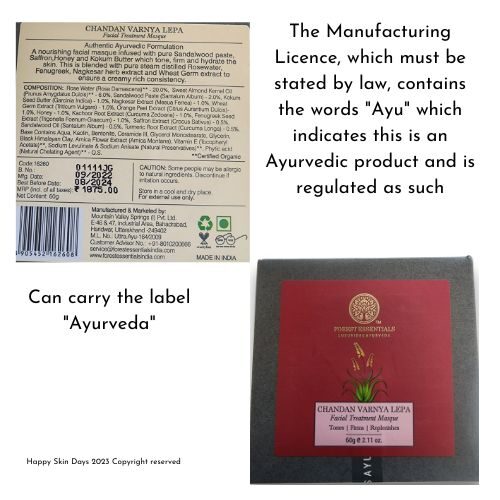Until quite recently, I could not have written this blog. BUT that changed this year, when Forest Essentials opened its first store outside India. Congratulations Forest Essentials, and here is a photo of their shop in London
Background…
Ingredient labelling of cosmetic products is very similar in Europe and the USA. India has multiple regulatory regimes because cosmetic products can be “Western” or of indigenous Indian origin (e.g.) Ayurveda products.
For example, a face cleanser could be an Ayurveda product or a normal facewash that you can buy in a mom-and-pop store. The Ingredient Label of Normal Facewash would be to disclose all ingredients in descending order of quantity and below 1% the amounts can be in any order. That’s pretty much the same requirement as in the EU and the USA.
Ayurveda products fall under a separate regulatory regime, requiring the manufacturer to inter alia, have an Ayush manufacturing licence. Printing the word “Ayurveda” itself on the face cleanser is only permitted if the manufacturer has such a licence.

Why is this important?
As an Indian, I want to give you some context. Ayurvedic products are generally perceived in India as being “natural” and as a consumer for me, having fewer synthetic chemical as well as no controversial ingredients (e.g.) BHT, silicones or parabens.
As a brand, having this Ayurvedic licence, I believe allows the brand to charge a premium and also, permits the brand to make claims on packaging. E.g., Forest Essentials Chandan Varnya Lepa translates as a Facial Treatment Masque on its packaging.
“Treatment” as a word would be difficult to find on clay masks in the EU.
So, in summary “Ayurveda” as a label, allows brands to charge a premium, benefit from the positive consumer perception AND allow the brand to make claims that otherwise they could not have.
And what does Forest Essentials’ have to do here?
Until recently, I could not have written this post, because comparisons of Ayurveda products is difficult when you only have a partial Ingredient list. All that changed, when (arguably) Forest Essentials’, India’s no 1 luxury Ayurveda brand opened its first store outside India, in the UK.
Forest Essentials’ is required to comply with EU regulation on cosmetic labelling, so “key ingredients” of (e.g.) a soap expands to a complete list of all ingredients. I have attached a photo of a soap showing the different labels
If you cannot see it properly here it is:
Bengal Tuberose soap (as sold in India)
Composition: Anamtmool Root Extract (Hemidesmus Indicus) 1%, Reetha Fruit (Sapindus trifoliatus) Extract 1%, Satavari Root Extract (Asparagus racemosus), Bengal Tuberose (Polianthes Tuberose) Flower Oil 1. Base contains Aqua, Sodium Cocoate (Saponified coconut oil), Sodium Palmitate (Saponified palm oil), Sweet Almond (Prunus Amygdalus dulcis) Kernel Oil, Glycerin, Raw Cane Sugar, Vitamin E
Madurai Jasmine & Mogra soap (as sold in UK)
Aqua, Sodium Stearate (Derived From Coconut Oil), Propylene Glycol, Sodium Laureth Sulfate, Sodium Cocoate (Derived From Coconut Oil), Raw Cane Sugar (Sucrose), Glycerin, Salt (Sodium Chloride), Parfum, BHT, Disodium Editronate, CI 42090, Reetha Fruit Extract (Sapindus Mukorossi Fruit Extract), Anantmool Root Extract (Hemidesmus Indicus Root Extract), Satavari Root Extract (Asparagus Racemosus Root Extract), Mogra Flower Water (Jasminum Sambac Flower Water), Jasmine Flower Extract (Jasminum Officinale Flower Extract), Linalool, Benzyl Salicylate, Hexyl Cinnamal.
(Source: Forest Essentials UK website on 25 Jan 23)
As a consumer of Ayurveda, I do want to point a few things:
First, I always thought that the fragrance of Forest Essentials’ comes from the fragrant flower in question. For example, Bengal Tuberose oil and no other added fragrances. But this is not the case, as the word “Parfum” on the EU label clearly shows there is an added unidentified fragrance oil.
Second, the preservative system of the soap is not disclosed in India, but of course it is in the EU and the fairly controversial ingredient BHT makes its appearance on the EU label.
And if you’d like to find out what my gripe with BHT is please click here to read more from David Suzuki and his dirty dozen chemicals.
Ayurveda products where art thou?
I love Ayurveda products.
Kama Ayurveda, Forest Essentials’ primary competitor in India has always been transparent about its ingredient list. I am happy to pay a premium to it for that reason.
I am not thrilled about Forest Essential’s lack of full disclosure in India.
Indian consumers deserve better – even if the law does not require full disclosure of Ingredient lists, perhaps brands should voluntarily disclose.
If the prospect of full disclosure makes you nervous, then perhaps its time to revisit your formulations.